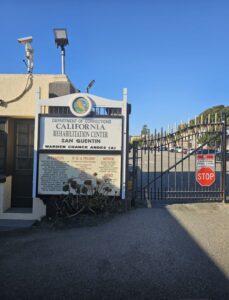
San Quentin Rehabilitation Center
“Them versus us” is not the right social attitude toward people serving jail terms, even when the magnitude of their crimes abhors us. This was our takeaway from a nearly four hour interactive session at San Quentin, California’s largest prison, which houses nearly 3,100 inmates.
The San Quentin Rehabilitation Center, formerly known as San Quentin State Prison, rests atop 432 acres, overlooking the bay just 12 miles north of the Golden Gate Bridge in Marin County. It has state-of-the-art amenities which include open playfields, laboratories for producing print and broadcast news, a congregational forum for diverse faiths, a central health care service to attend to medical emergencies. The inner walls of the correctional home sparkles with colorful murals made by the inmates. Their humanitarian themes attest to San Quentin’s mission to reform itself.
A thought-provoking conversation with five inmates was the highlight of our visit. It triggered in us human reflections that underlined the need to put our own convictions to scrutiny, for much of what we believe to be rational could be an extension of the discriminations around us.
“Why do you think one is put in prisons?” asked Oscar, an inmate. Various responses followed: To isolate them. To prevent further criminal activity. To deliver justice to the aggrieved. To deny them freedom as they have forfeited it.
Perhaps, the too many “they” and “them” caused dissonance among the inmates who inspired us with their calm demeanour and stirring reflections on the tribulations of life. Oscar shared his dismay that these responses created a binary of “us versus them.”
He said the real purpose of prison is to reform. To stir a sense of guilt. To create compassion, which will be powerful enough to replace the aggression, envy and disillusionment that often culminate in criminal behaviour.
“I have the opportunity here to transform myself,” said Oscar, who is in his mid-30s and has been in prison for 15 years. “To be known not by the heinous act of the past, but by my preparation to live life with a sense of responsibility, dignity and brotherhood, were I to be set free.”

Reflecting on the question how do they find motivation to live on given the fact that some of them may never be out, an inmate attributed it to their understanding that the sentences they serve are in some sense the healing for the families whom they have caused grievous harm.
“I know I have taken away from some people their loved one,” he said. “I have also got separated from my loved ones. This helps me understand the enormity of what I did. And this understanding is vital to reforming myself.”
Dating back to 1852, incarcerated persons built the prison. They labored during the day and slept on the prison ship, the Waban, at night. Today, it is an example of humanizing correctional homes. Yet, there were evidently far too many Black people in the prison, as one observes at first glance. This upholds the vexing debate on racial discrepancies in the U.S. justice system.
This fellow asked Rashad, an inmate serving more than 100 years of jail term, whether or not some of them had the feeling that they had been more harshly sentenced because they lacked access to resourceful defense.
“That’s the feeling in so many of us,” Rashad exclaimed.
A report by the United States Sentencing Commission published in November 2023 found that Black males received sentences 4.7 percent longer than White males.

Rashad was afraid that this could also impair parole opportunities for some, as parole sometimes depends on the capacity of family and friends to mobilize support. In 2021, The Center on Race and Inequality along with the Parole Preparation Project issued a comprehensive report, “The Problem with Parole: New York State’s Failing System of Release.” It noted people of color were 30% less likely to be released in 2022 and 2023 than their white counterparts.
San Quentin has an advanced media laboratory run by the inmates who rotate turns as researchers, writers and editors to bring out their publication and documentaries. These delve into prisoners’ experiences and the life-changing learning experiences being witnessed there.
They said it was important to get the word out on San Quentin’s endeavor to reform prison experiences. The incarcerated journalists are hopeful that their writing will mollify public attitudes toward them, which is necessary for their reintegration into society if and when their sentences end.



